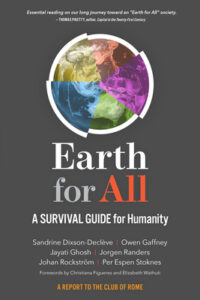Earth For All: A Survival Guide for Humanity

Awoenam Mauna-Woanya
SpaceshipOne book club member
In an era of climate-doom-scrolling and climate conferences funded by fossil fuel lobbyists, “Earth for All” (E4A) by Sandrine Dixson-Declève et al. arrives as a beacon offering a clear, policy-oriented path forward. Much like many recent climate books, it argues that the climate crisis isn’t an inevitable consequence of human nature but rather a symptom of our highly inequitable, extractive economic systems. However, what separates E4A is that its proposed solutions have all been modeled in a systems dynamic model (called Earth4All).
A systems-based approach to climate solutions
This modeling approach makes E4A one of the best systems-solutions-oriented books on our climate crisis. Its strength lies in exploring several scenarios for our path forward, considering well-being and social tension indices. This book specifically lays out two contrasting scenarios: “Too Little, Too Late” (TLTL), a bleak continuation of our current trajectory (aka business-as-usual), and “Giant Leap,” a bold transformation towards a more equitable and sustainable future.
The authors, a collective of scientists and economists, propose rebuilding our current economic systems by approaching five interconnected “turnarounds” that can deliver prosperity by 2050. These turnarounds tackle the root causes of the climate crisis by:
- Ending poverty,
- Addressing gross inequality,
- Empowering women,
- Making our food system healthy for people and ecosystems, and
- Transitioning to clean energy.
Suggestions for Improvement
I loved E4A and really have to nitpick to find faults with it. E4A clearly presents its solutions using accessible language, direct subheaders, and engaging visual aids. These aids (mainly graphs and charts) allow you to visualize the pathway for achieving each solution. However, the book could have more narratives and be more interactive. Firstly, integrating more personal narratives could contextualize the impact of these turnarounds.
One of my favorite parts of the book was following the lives of four women in different parts of the world through the two scenarios presented. We see how climate change and economic injustice intertwine and how the “Giant Leap” solutions can empower individuals and communities to make a difference. Both scenarios genuinely felt realistic; the “Too Little, Too Late” left me in despair, and the “Giant Leap” motivated me to keep fighting for a better world. These narratives, had they been continued through each chapter, could’ve made it easier for me to connect with why it is important we implement these solutions.
Secondly, incorporating an easily accessible online dashboard, much like OurWorldInData, could provide a more interactive experience while exploring the various scenarios in more depth. The graphs and charts, helpful as they are, are static and in shades of gray. I often found myself examining them closely to distinguish the shades of gray or wanting to see how multiple charts are impacted by each other.
Implementing Change: A Call to Action
E4A’s proposed solutions are ambitions yet grounded in common sense. Advocating for wealth redistribution (the wealthiest 10% shouldn’t take more than 40% of national incomes) and citizen-fund-based economies may be radical relative to our current system, but E4A argues convincingly that our current systems have failed the majority of people already. I can imagine the myopic opposition to these ideas, but it’s our job to educate and show how they’ll be beneficial.
When I ask, “What now?” I can’t help but think it’d be awesome to have some kind of “Ministry for the Future” with real power to implement the roadmap in E4A. While E4A proves to be a valuable education resource, it felt like a blueprint delivered to the wrong door, meaning that this book really should be read by today’s leaders in search of systemic solutions. While I hope to one day be able to implement these solutions directly, I can still learn what a better system looks like and urge our leaders to implement them.
Ultimately, “Earth for All” is a powerful call to action: an injection of optimism, wrapped in a healthy dose of realism, steeped in data-driven modeling. It is a book that instills hope and reminds us that we have the tools and knowledge to create a better future; it’s up to us to demand it. Every page of my copy has some kind of scribble or annotation because it is an excellent guide for framing these big-picture solutions. It is a must-read for anyone who wants to understand the solutions to our climate and economic crises and who is committed to taking action to achieve them.
